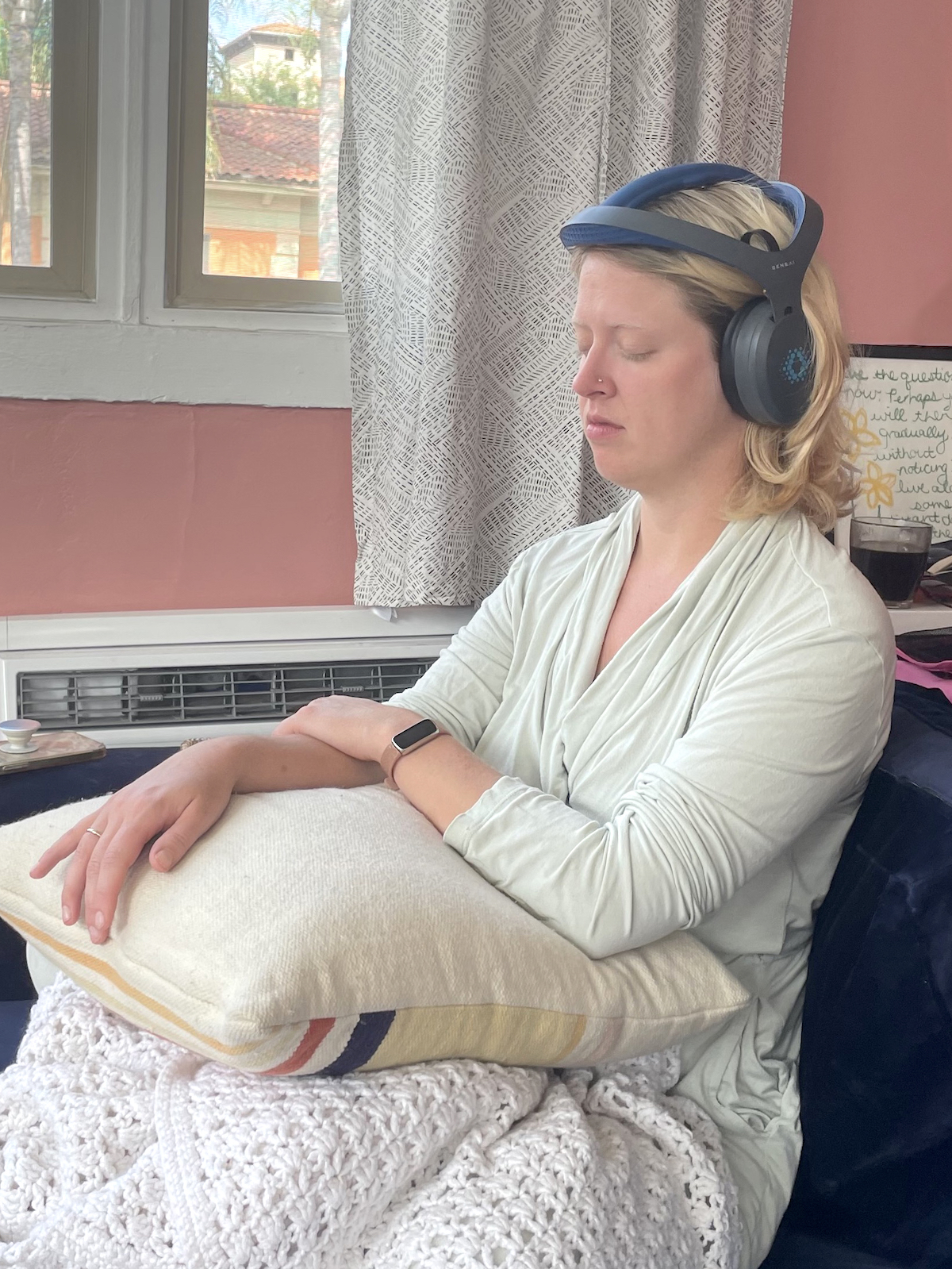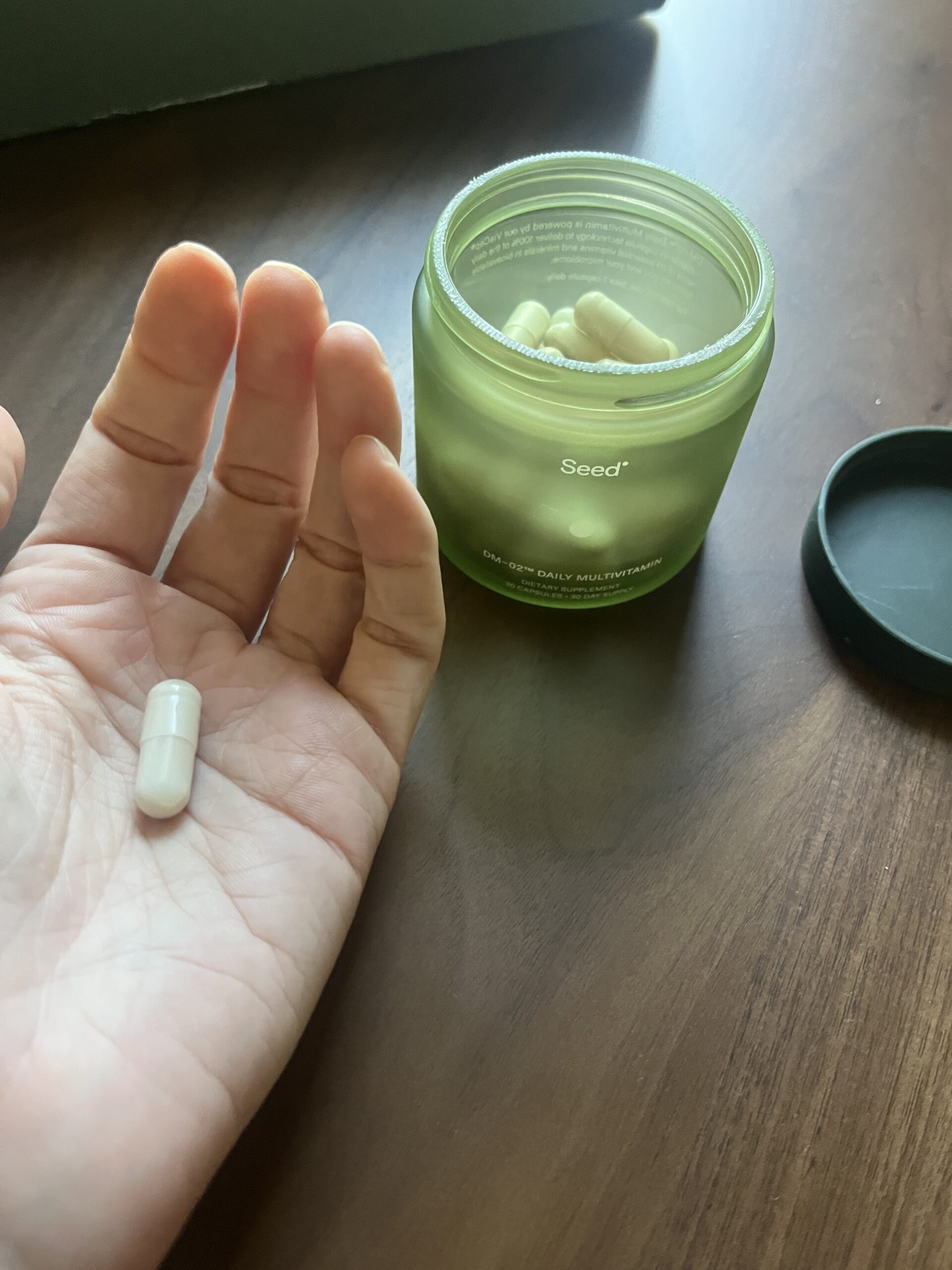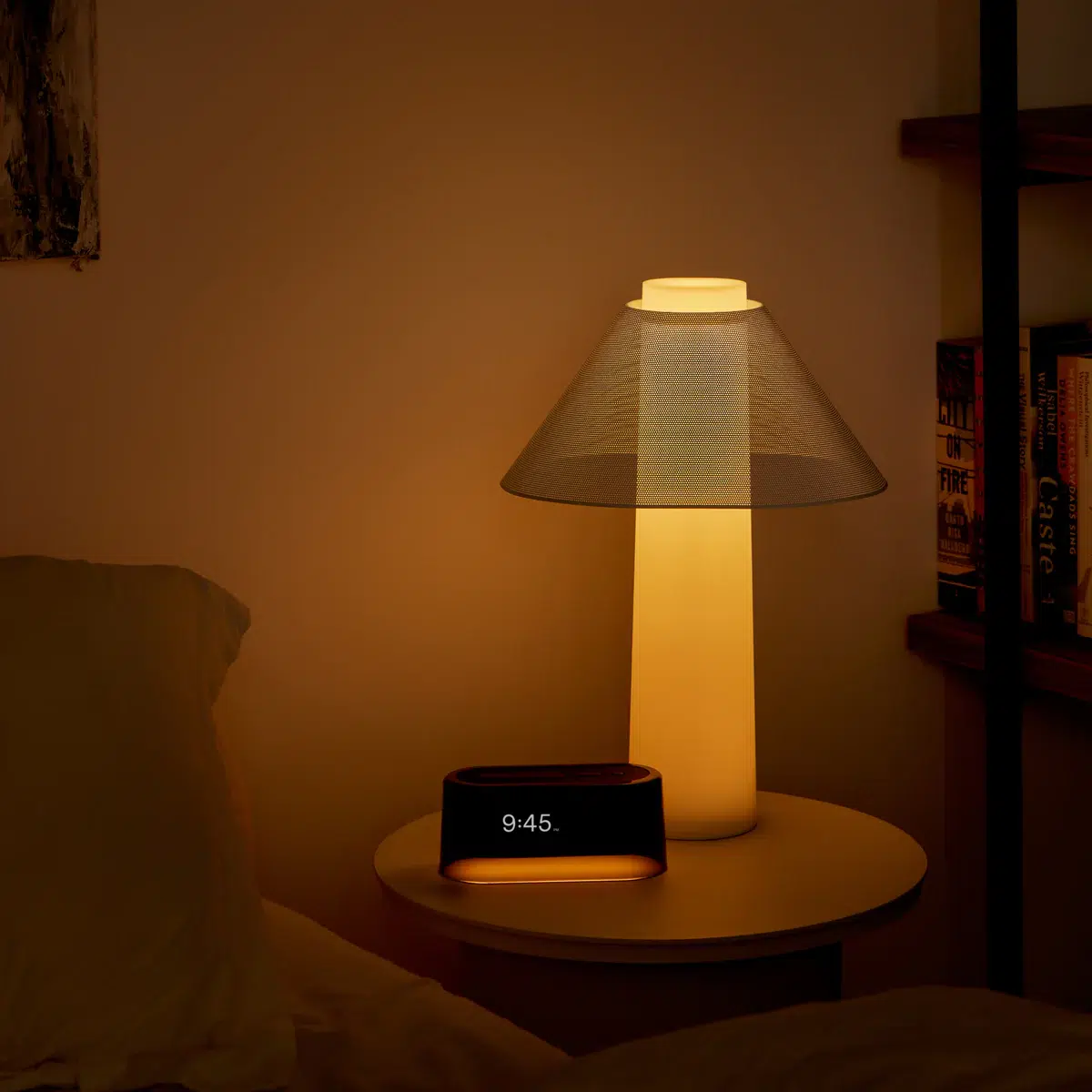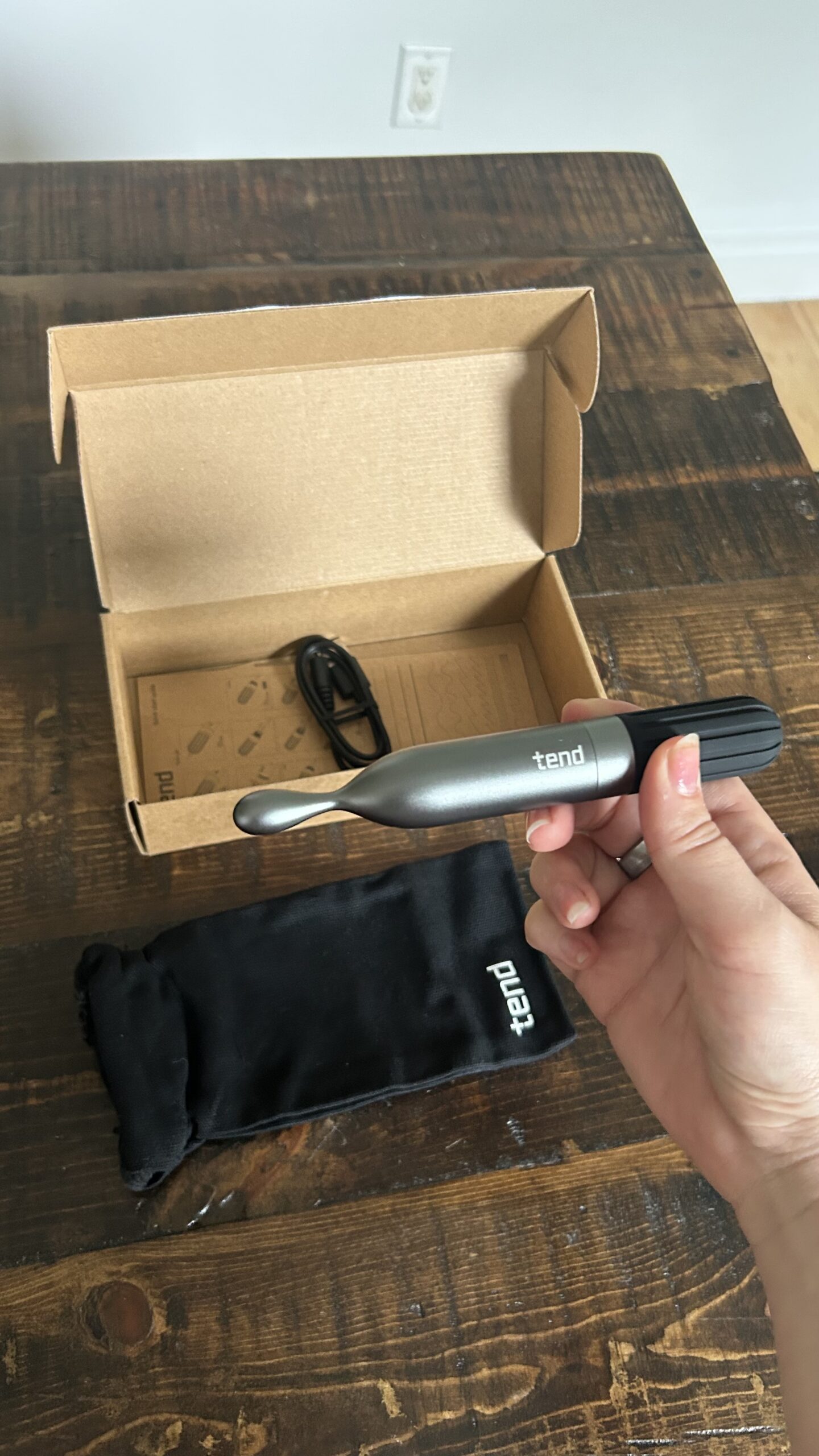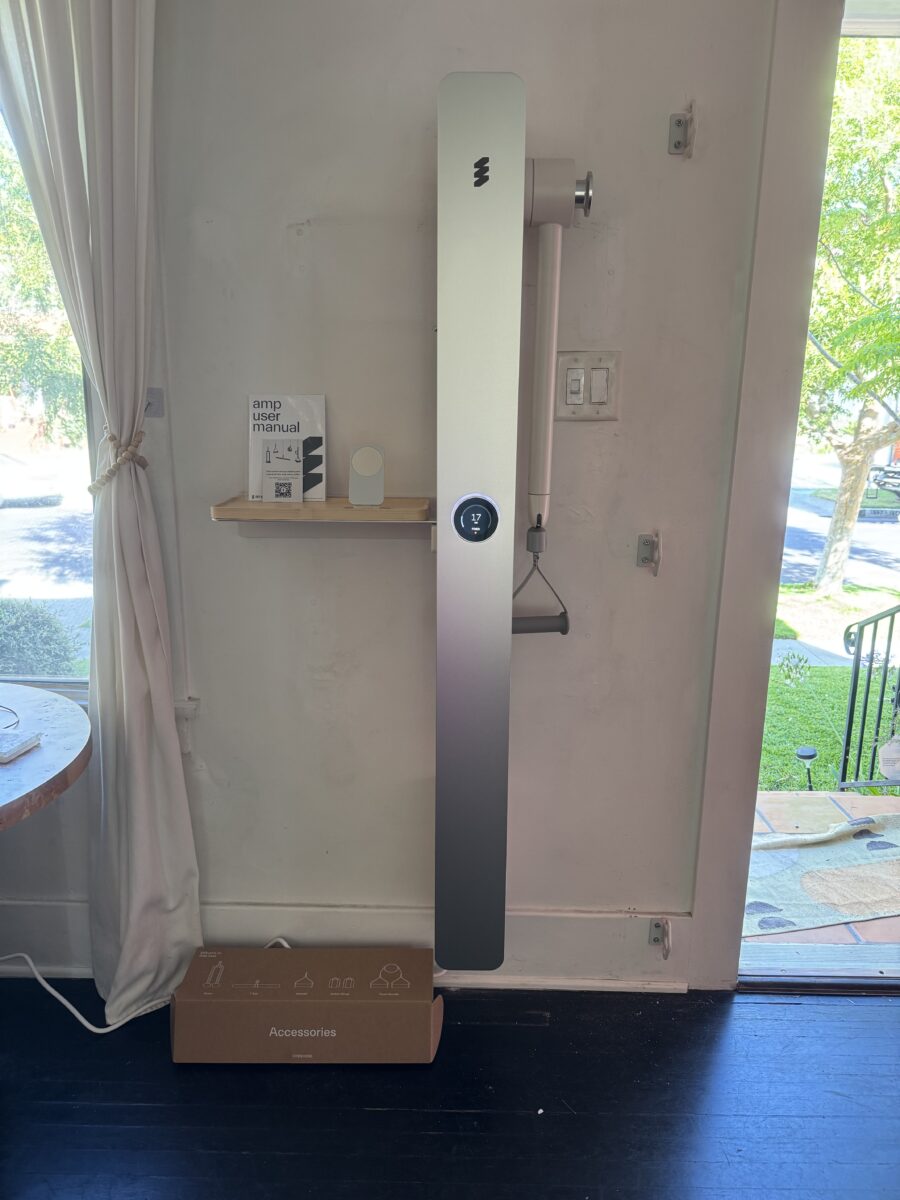
Is Amp Worth The Investment? We Share Our Honest Review And Results
Good Gear editors endorse products we’ve personally researched, tested, and genuinely love. Learn more about our methodology and business model here.
GOOD GEAR RATING — 8/10 STARS
Summary: Amp is the first thing I’ve ever used that makes strength training at home feel addictive in the best way. It’s insanely smart, beyond beautifully designed, and has somehow turned me into the kind of person who looks forward to working out in her own living room — and lovingly staring at this machine when I’m not. It’s that effective and chic.
What I Love:
- The Amp’s design is minimal, sculptural, and doesn’t mess up my space. It’s whisper-quiet and wall-mounted so there’s no clutter.
- It’s super smart. The machine tracks tempo and output and gives you weekly reports with your results, if you want them. The brand’s adaptive AI also evolves my resistance according to my performance every session.
- With these workouts, I’m getting eccentric overload and controlled resistance, which helps me meet my goals. Amp offers fixed, eccentric, and band workouts so you can decide.
- I can knock out a short, efficient session and still feel like I trained hard without ever having to leave the house
- There is a custom class design where I can create my own class based on what body parts I want to work on, how long I have, and what mood I’m in. There are also hundreds of classes that you can follow as is, with options to slightly customize as you go proceed.
Things To Keep In Mind:
- The upfront price might feel high at $1,795 (excluding tax) for the equipment and another $23 per month for the subscription — but financing helps, and if you break it down to months of use, it’s comparable to a boutique workout class budget.
- It has to be wall-mounted so it may not be ideal for renters or frequent movers.
- If you’re looking for a machine that does everything, know that Amp is laser-focused on strength. If you understand body mechanics, you can definitely increase your heart rate. It’s just not the kind of cardio you’d get from a spin class.
- If you’re more into cardio dance, live group classes, and need outside motivation, you’ll need to rely on yourself to motivate with Amp.
At some point, every fitness-loving person with taste hits the same wall: We want to train like athletes — but without living in a garage gym that looks like an equipment graveyard. I’ve tested nearly everything from kettlebells tucked under the couch to resistance bands hanging off doorknobs, to cardio machines I’ve used twice and then sold on Craigslist. Nothing felt complete. Some options were effective but ugly, others were beautiful but gimmicky. I wanted a system that was truly smart: One that delivered serious strength training, adapted to me, and didn’t mess up the flow of my home. Enter Amp.
What is Amp?
Amp is an AI-powered, wall-mounted machine designed for full-body strength, progressive results, and minimalist aesthetics. It doesn’t feel like clutter, but instead intelligent training that fits into your actual life, and your actual living room. The brand uses AI-powered adaptive resistance to deliver dynamic, data-driven workouts. It’s a sleek, design-forward alternative to bulkier machines, and one of the few products built specifically for real strength training. My favorite part is that Amp looks more like a piece of sculptural decor than fitness gear, followed closely by how it achieves results.
Behind that minimalist frame is some of the smartest training tech I’ve ever used. The system uses motorized cable arms that create dynamic resistance, meaning the load changes depending on how you move. It’s not just heavy or light; it’s responsive. Adaptive algorithms read your effort in real time and adjust each rep to keep you in the sweet spot between challenge and control. Everything runs through the Amp app, which tracks your performance, guides your workouts, and logs your progress without you having to think about it. And if you want to switch it up, there are accessories like handles, ankle cuffs, and a bar you can snap in for different movement patterns.
Working with Amp requires a monthly app subscription, which unlocks the full library of programming and data analytics. There are no big ugly screens with hyper instructors shouting at you, just filmed videos, a soothing voice. The real coach here is the AI resistance genuinely reacts to you mid-movement, tweaking load and tempo so the system feels like more than just hardware.
Who is the team behind Amp?
Then there’s the brain behind it: Amp was founded in 2021 by Israeli entrepreneur Shalom Meckenzie, who built and sold a successful sports-betting tech company (SBTech) before launching Amp. His leadership team includes engineers and designers from heavyweight firms like Apple, Facebook, and Nike.
“Amp’s team conducted a year and a half of user research…to make sure they weren’t just building something that looks slick but actually works in real homes.”
They also did their homework: Amp’s team conducted a year and a half of user research, logging thousands of test hours and participant feedback to fine-tune the UX and hardware to make sure they weren’t just building something that looks slick but actually works in real homes.
In other words: The brand isn’t just riding hype, it’s leaning on real tech, thoughtful design, and expertise.
My experience training with Amp
Delivery & setup
While Amp is a home gym, the brand doesn’t expect you to get to work until after installation. Their delivery and white glove setup are included in the cost of your machine. I appreciate that for an investment of this size, and because of the precision needed for the technology, it’s really a non-negotiable.
“Delivery and white glove setup are included in the cost of your machine.”
My delivery team was great. There was lots of clear communication and they were on time and super kind. . I got texts confirming delivery timing, updates the day before, and a heads-up when the team was on the way. Before they even showed up, I was asked to scout a couple of potential install spots. They came in, assessed the space, located the studs, made sure the baseboard wasn’t in the way (the unit needs to be a certain height from the ground), and got to work.
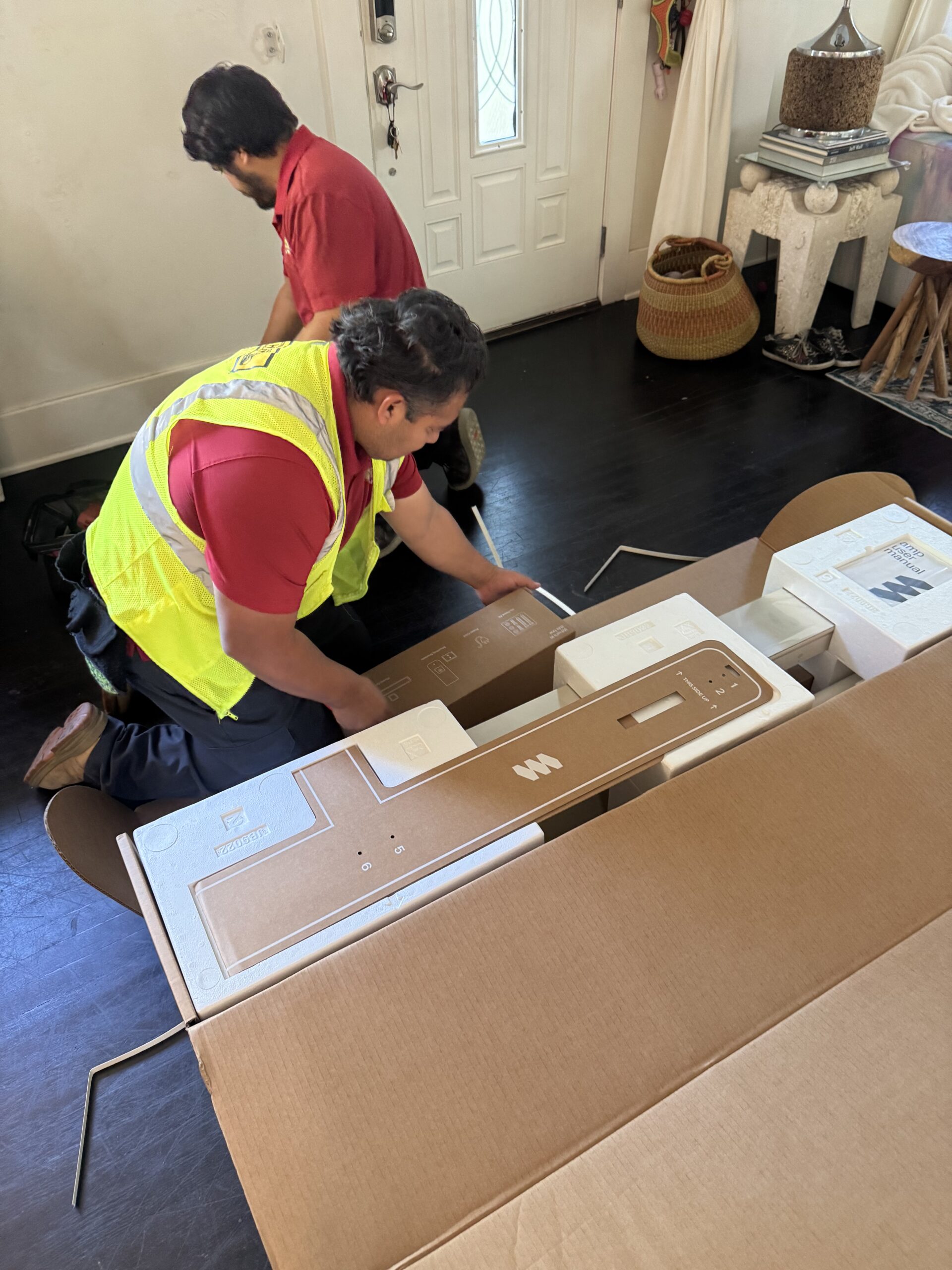
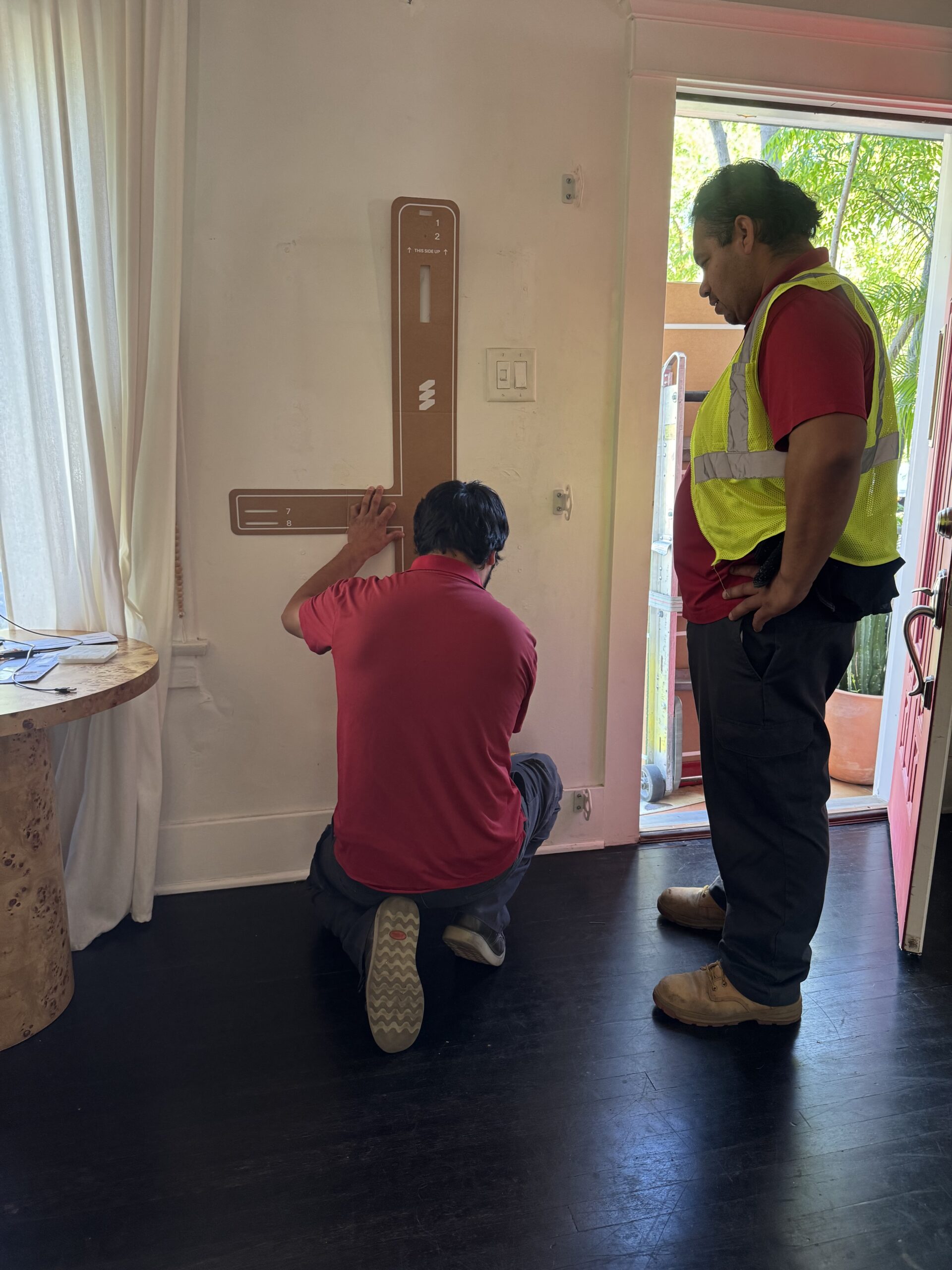
From box to mounted, it took about 30 minutes. Once it was up, we plugged it in, connected to Wi-Fi, and that was it. It was live. I had expected something more complicated. But the whole thing felt weirdly simple, in the best possible way.
My first workout
The first time I used Amp, I basically lost my mind. As a trainer who’s road-tested every fitness gadget out there, this one genuinely blew me away. The app was immediately intuitive, no spinning wheels, no digging through menus. I could choose from strength circuits, glute-focused work, core, upper body, you name it. These aren’t “classes” in the traditional sense. No one’s talking at you. You follow along as the screen shows a human in real-time, modeling tempo with clear and efficient cues. The instructor’s voice is quiet and kind, with none of the forced pep-talk energy I loathe. Their form is always solid and the whole thing looks clean and cool.
“As a trainer who’s road-tested every fitness gadget out there, this one genuinely blew me away.”
I quickly realized that Amp looks minimal, but there’s a lot going on under the surface. The wall-mounted panel is sleek and low-profile, like a vertical slab of sculpture, and attached to it are two adjustable arms that move up and down along a smooth track. You can set the arm height depending on the movement you’re doing: High for lat pulldowns or tricep extensions, low for rows or glute kickbacks. The app tells you exactly where to place the arms, and the system gives you a visual cue each time to make it easy.
Each arm connects to a cable that delivers motorized resistance. There’s no clunky weight stack, no loading or unloading plates. You simply clip in the handle or bar attachment, and the resistance begins automatically, based on your strength, history, and real-time output. It’s wild. The weight increases or decreases while you’re moving, which means every rep gets adjusted as you go. If you’re coasting, it nudges you higher. If you’re struggling, it eases off just enough to keep you in the work without breaking down form.
“You simply clip in the handle or bar attachment, and the resistance begins automatically, based on your strength, history, and real-time output.”
Before each session, there’s a quick calibration to test your range of motion and baseline output that day. I must admit that this part confuses me a bit. The app says it’s doing a strength assessment, but then nothing happens. It doesn’t ask me to do a rep or anything. I assume it’s performing some magic within the app by calculating my last class or workload and adjusting the upcoming lesson accordingly. Then you pick your session from over 400 scenarios. Glutes, full-body, HIIT, core power, whatever, and you’re off to follow along. The workout videos are beautifully shot, with trainers moving through each set while a soft, non-distracting voice cues the time and tempo. No one’s yelling. No one’s calling you out. You’re just watching and mimicking with the machine is doing all the adjusting behind the scenes.
I’m most excited by Amp’s application of eccentric overload, which is just a more effective way of building strength. It emphasizes the lengthening part of the rep, which is where a lot of growth and control happens. And while that might sound technical, it just feels like your muscles are working harder in a good way. The system logs everything: Total volume, time under tension, movement patterns, so you can track progress without having to think about it if you’re into that kind of thing. Me, not so much. But it’s there if I feel like nerding out on data.
It’s smart. But it’s also designed in a way that makes it incredibly easy to just show up and go. And that’s what makes it so different.
Long-term results & feedback
It’s only been about four to six weeks, but the shift I’ve experienced is real. I’m showing up more consistently, lifting with intention, and actually building strength without needing to leave my house or change my clothes. I used to take studio classes, but they just became too much — too much time, too much effort, too much everything. Amp removed all of that friction. I’m no longer spending half my day commuting, parking, hoping there’s space, or stressing over whether I’m going to get into a class. I just walk up, turn it on, and start.
That ease is what made it stick. I can jump into a session at literally any time of day, wearing whatever, and still get a meaningful workout. I can train smarter in 20 minutes than I used to in 60, and that’s not an exaggeration. Amp made it possible to shift the way I think about movement; it’s no longer something I have to “fit in.” It’s just there, waiting, and because of that, I’m doing it more.
But here’s the bigger thing: Muscle is the currency of longevity. More than cardio, building and maintaining muscle is what protects you as you age. It supports your joints, stabilizes your spine, regulates your metabolism, and improves quality of life in ways no fitness trend can touch. Amp makes it easier to get there. It’s not about chasing intensity; it’s about building a lasting, strong foundation. And I feel that happening already.
The Amp doesn’t feel like something I’m going to burn out on or forget about in a few months. First of all, it’s staring at me in my living room. I’ve tried a lot of fitness tools at home, and most of them lost their appeal pretty fast. This one keeps pulling me in. It’s easy, it works, and it somehow feels like it’s working with me, not demanding anything from me.
“This one keeps pulling me in. It’s easy, it works, and it somehow feels like it’s working with me, not demanding anything from me.”
The only small hiccup I’ve noticed so far is with the arm adjustment, the track that lets you slide the arms up and down for different moves. Occasionally, it sticks a little. I reached out to the team, and they told me that’s totally normal when the unit is still new. It’s something I’m keeping an eye on, but it hasn’t affected my workouts, just something to know if you’re installing one and it doesn’t glide like butter right away.
Another small note: When the app cues you to move the arms to a certain height (like “Level 5” for chest or rows), the demo model is usually a lot taller than I am. I’m 5’4″, so when the 6’2″ guy in the video is pulling from Level 5, that doesn’t necessarily line up with how the move should feel in my body. It would be helpful if Amp offered a height range (like “Levels 4–6, depending on your height”) or even auto-adjusted based on your setup calibration. Maybe it already does. I’m honestly not sure, but I did find myself making a few intuitive tweaks just based on how the move felt.
Also — the attachments. There are several handle and bar options, and I love how easy it is to swap them in, but I wish there were a little storage solution included. In the videos, there’s often a sleek shelf or a mounted hook shown, but I didn’t receive anything like that with my unit. Something small and design-forward to keep the accessories off the floor would be a really nice touch. It’s something I’ll be adding myself to my Amp setup.
Is it worth it?
Once you realize you can knock out a full-body, muscle-building workout in 20 minutes, in your pajamas, no less, it’s game over. Amp is officially part of my rotation, and honestly, I don’t see myself burning out on it the way I have with every other fitness thing I’ve tried (looking at you, Burn 60, Training Mate, Barre class circa of 2021). This meets me where I am mentally, physically, logistically, and aesthetically.
“Once you realize you can knock out a full-body, muscle-building workout in 20 minutes, in your pajamas, no less, it’s game over. “
Amp runs $1,795, which includes the unit, five accessories, white‑glove delivery, installation — and a risk‑free trial window that gives you time to make sure you actually like it. And there’s the subscription of $23/month included for the first year, which covers the workouts, tracking features, and app updates. You can reserve one with a $99 deposit that applies to your purchase, and yes, it’s refundable if you change your mind.
If you’ve ever scraped your car in a gym parking lot, gotten a ticket while rushing out, been charged for missing a $30 class, or dropped out two weeks into a $199-a-month membership, Amp’s convenience alone makes it worth it. It might feel like a splurge upfront. Simple math says if you add time and energy saved, it pays for itself. Fast.
If you love results but hate gyms, and also refuse to let workout gear hijack your living space, this is your sweet spot.
Emily Wagner is a beauty and wellness industry veteran, editorial voice, and creative strategist known for her discerning eye and no-BS approach to product discovery. She is the founder and Editor-in-Chief of Groomed LA, a long-standing digital magazine covering the latest in skincare, wellness tech, longevity, and next-gen beauty as well as Micropause, a modern supplement brand supporting women through perimenopause. Over the years, she’s tested everything from red light masks to powdered peptides to sleep tech — always with a sharp mix of skepticism, curiosity, and deep research.

